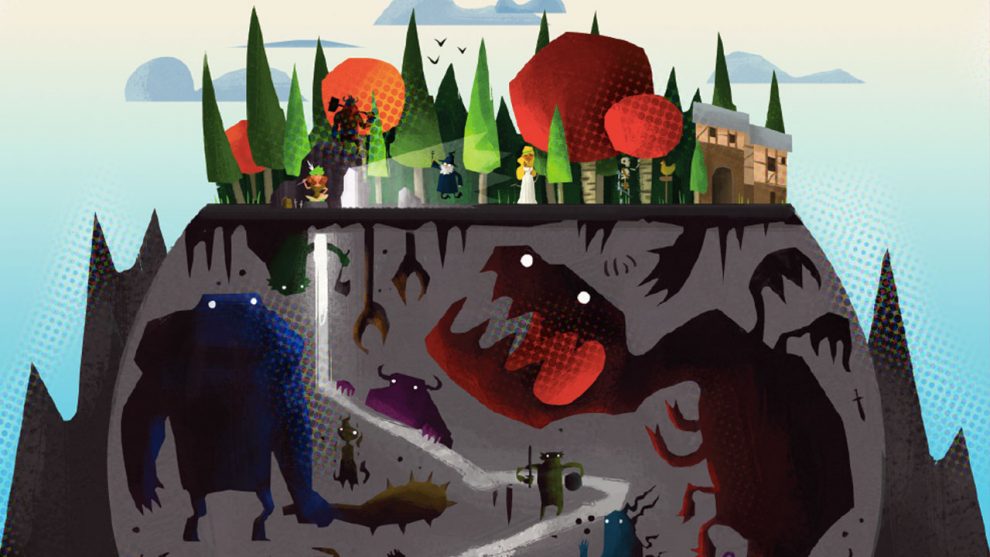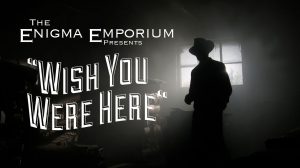Disclosure: Meeple Mountain received a free copy of this product in exchange for an honest, unbiased review. This review is not intended to be an endorsement.
I grew up playing an old, busted-up copy of Crokinole in my grandparents’ living room. The classic Canadian game of skill asks players to do one thing: flick their discs across the board. Aim true, and you’ll make contact with the opposing pieces— maybe even knock them off the field. I played until my index finger ached, bruises forming under the nail. Today, my cousins still beat me more than I’d like to admit.
So when I heard about Catacombs, I knew I had to try it. Developed by the equally-Canadian Elzra game studio, Catacombs takes the bones of Crokinole and dresses it up nice in a dungeon-crawling skin. The dexterity trend isn’t new, but neither is the game: before Flick ‘Em Up, before Ice Cool, before Terror in Meeple City, Elzra released the first edition of Catacombs. It was lauded with critical praise, winning Most Innovative Game from both The Dice Tower and BoardGameGeek.com. It was also… shall we say… not the most attractive board game.

It wasn’t until four years later that Elza contracted illustrator Kwanchai Moria, whose art radically changed the look of the game. These sweeping artistic changes would come with new mechanics, updated rules, and additional content for the best-known third edition of the game.
Several expansions and a couple spinoff games later, 2018 marks the eight year anniversary of Catacombs’ original release. So how does the third edition hold up? Well, before we get there, let’s talk a little about How Catacombs Works.
How Catacombs Works
Players in Catacombs will take on the classic roles of a Dungeons and Dragons game: wizards, mages, barbarians, and thieves. And a skeleton. …And a chicken.

Each person is in charge of one or more Heroes, all with their own unique characteristics and special powers. There are always four Heroes in the game, so you could be operating anywhere from one to four adventurers.
These Heroes share a common goal: to defeat the nefarious Catacomb Lord, thereby saving the town of Stormtryne. Who is this Catacomb Lord, you ask? That’s going to depend on who’s the best at flicking wooden discs.
See, much like in a game of DnD, one player has to act as a kind of moderator/world-builder/antagonist. This person is known as the Overseer. The Overseer has a few important jobs: first and foremost, they control the team of monsters. Every bad guy on the board is going to be sent off with a quick flick from the Overseer. Second, the Overseer is a kind of architect for the adventure. They choose what rooms the Heroes will be travelling through.
Every game of Catacombs has the same basic structure: before the game starts, the Overseer selects a series of nine room cards. A room represents one battle between the Heroes and the monsters; you can think of it like a skirmish. The room card tells the Overseer what monsters will be on the board and how hard that room is considered to be.

Both teams (Overseer and Heroes) set up their pieces on their side of the board, then play begins. In any given room, Heroes will have the first shot. Play proceeds back and forth, with each team getting one move per character. If all the monsters are killed… hurrah! Onto the next room. If all the Heroes are killed… game over. Bad guys win.
Once the Heroes reach the last room, it becomes a battle between them and the Catacomb Lord— a very powerful foe and its horde of minions. If the Heroes manage to kill the Catacomb Lord, they win the game! Time to grab a drink at the tavern and ask the bard to sing song about your adventures. Or maybe bribe them not to. You know how bards are.
What Does a Turn Look Like?
The real strength of Catacombs is that it mirrors the well-known structures of traditional tactical tabletop RPGs. Let’s break it down.
On any given turn of a traditional RPG, you choose your ability, check what kind of effects it has, and then roll the dice to see if you hit (and how much damage you do). In a Catacombs turn, you choose your ability, check what kind of effects it has, and then flick your piece to see if you hit (and how much damage you do).
A Hero will be choosing between their “standard shot” (which usually involves flicking their own piece across the board and trying to hit the enemy) and using one of their items, abilities or spells. Abilities let Heroes take ranged shots, do extra damage, or cause status effects.

This array of options is another of Catacombs’ core strengths: by creating a rich suite of powers, the game transcends the trappings of themeless dexterity and becomes an immersive experience. At the same time, it takes a traditionally luck-based combat system and elevates it into a game of skill… and, it does this without sacrificing the thrill of the fight. Will I land this blow? Only one way to find out.
Deep Dive into Catacombs
This review has taken longer than any other piece I’ve written for Meeple Mountain. That’s due in large part to the fact that Catacombs is kind of huge, and very different from a lot of other games. This has given me a lot of time to think about just what makes Catacombs the kind of game that it is. I’m going to break this into sections to talk about the unique strengths (and some weaknesses) of this unusual game.
Variability
I’ll make a bold claim here: Catacombs has more content than any other dexterity game on the market. You could play two games of Catacombs and see an entirely different set of monsters, levels, and items. The game comes with a wide array of characters cards, tokens, and even boards.

In some ways, this is both a blessing and a curse.
I love the idea that this game can be played in dozens of permutations: there’s so much flexibility in what you want your session to look like. If I want my group to have a unique experience tailored to their skill level and character preferences, I can design the exact dungeon that I think would give them the most challenge and excitement. If an Overseer just learning the ropes, they can take the game’s recommended settings for an early trial— up to and including the exclusion of a bunch of advanced powers and monsters that might be a lot to juggle for first time players.
On the other hand, that’s a lot of responsibility in the hands of the Overseer player. While you’re welcome to quasi-randomly choose a series of rooms and monsters, it almost feels like you’re not taking advantage of all the amenities the game has to offer: you are the architect of the adventure and responsible for the experience of the other players. Designed recklessly enough, certain combinations of characters and rooms can feel a little lopsided.
Fortunately, an industrious userbase has thought about this already. In addition to ability cards to buff up some of the weaker Hero abilities, there’s a full dungeon builder spreadsheet that will recommend which rooms and Catacomb Lords to use based on which Heroes are in play. This kind of homebrew spirit makes a lot of sense to me with Catacombs: I can totally imagine an excited player designing new monsters, items, and characters. All it takes is a reference card and a sense of curiosity.
Footprint
As you might imagine, then, Catacombs has a lot of stuff. Tokens and cards will sprawl across the table in a landscape of game in-progress. The game is large enough that it outstrips smaller tables pretty quickly.

The silver lining to Catacombs’ size is that not everything is in play at the same time. If you’re really crunched for space, Catacombs only needs to take up as much room as the arena you’re looking at this round. While it’s convenient to keep the horde of tiles, boards, and decks of cards nearby, they’ll never all be in use simultaneously: you’re pretty safe to keep only what you need now on the table. In a particularly small space, I can imagine players holding their cards in-hand and foregoing the player aids entirely. But it’s not ideal.
For this reason, I think Catacombs would be a perfect candidate for app integration. A digital tabletop would cut down on the real estate significantly, allowing players to outsource the health and ability management. This has been done before– games like Gloomhaven and Munchkin have introduced software to streamline your dungeon crawling. But those are bigger productions.
For now, your best bet on cutting down Catacombs is picking up its small box alternative, Catacombs Conquest. Our review on that is coming soon.
Accessibility
The best thing that happened between the first and third editions of Catacombs was not, in fact, the gorgeous art. It was the introduction of icons.
Icons play a crucial role in how players interact with the game. Each ability is explained by some combination of symbols showing what the shot sequence of the turn will look like. By and large, these are both intuitive and consistent. A red colour will always mean double damage and an arrow will always mean a ranged shot— whether we’re looking at a character’s abilities or a monster’s. These icons are combined in all kinds of ways, and without them, the game would require long descriptions. With the icons, players can navigate their abilities and adversaries at a glance. That’s fantastic.
That being said, even the clearest icons need someone at the table who knows what they mean. There is some forgiveness built-in for new players: each round, only so many monsters will be on the field, so there’s only so much to remember. Even better, earlier rounds tend to have less funky symbols— weaker monsters have more basic shot types and the game only grows in difficulty as it closes in on the final battle.

The trick here is that the one person who knows it should really know it. Otherwise you’ll be doing a good chunk of flipping in the rulebook at the start of each new round, slowing down the game.
There are other ways to open the game up to less advanced gamers: people can be assigned Heroes with more intuitive abilities; the game provides a set of rules that can be held back until players know the system; and, handicaps are offered for players who may not be as dextrous.
Clarity
Stop me if this sound familiar: as Jim pulls a block from the Jenga tower, an argument ensues. Did he steady the tower with his hand while he pulled the block? Was that probing he did to find the right block okay? When that single block fell off the side, was that the end of the game?
In a lot of dexterity titles, you can run into problems of clarity. Sometimes it’s because the rules aren’t clear, but other times it’s just a fact of life: without a laser measure and a slow-motion replay, you can’t always be sure what happened.
Catacombs manages to sidestep these concerns with a few clever rules, the first of which is a very obvious out-of-bounds mechanic. The game board is surrounded by walls, with a gap between them and the board. If a piece falls into this “moat,” it’s considered out of play. This is a great way to stem the question of “does that count,” since any ambiguities just end up back on the board at the point of exit.
Catacombs also has a clever system of tracking hits. Whenever a pawn is directly hit, they take damage. If they’re hit in a domino-like daisy chain from another affected piece, no damage is taken. With a lot of moving pieces, this allows players to only focus on the one that’s actually being fired.

For a game with a whack-ton of abilities, exceptions, and real-world impact mechanics, Catacombs produces surprisingly few moments of ambiguity.
Engagement
There’s no way around it: for a game of dungeon crawling bumper cars, Catacombs is pretty dang long. Heroes have to travel through a series of nine rooms, building their arsenals and protecting their health as the game slowly builds towards a final battle. Creating that traditional dungeon crawler feel takes a while.
There are a few things that work in Catacombs’ favour here. The first is that players have a natural built-in drive to excitement: whether you start in chairs or not, everyone’s gonna be standing within the first five minutes. Getting the right angle requires walking around the game board.
The second thing that keeps Catacombs moving along is that you’re all kind of rooting for each other. Sure, as the Overseer, you don’t really want your monsters to be sniped off the board… but a good shot is exciting for everyone. The Hero team eagerly discusses best approaches, since players get to decide what order turns happen in. It looks a little like a war room: everyone leans over the table, pointing at possible trajectories and what-if shots. It’s hard not to get swept up in the excitement when a plan comes to fruition.
I should note that the advanced play mode has permanent death for Heroes, meaning that players could be eliminated from the game. Fortunately, this play mode is optional, so those who are concerned about leaving someone out to lunch don’t have to play with this rule.
Sealing the Tomb
If you can’t already tell, Catacombs gets a big thumbs-up from me. I don’t believe it’s a perfect game. I do think it’s a near-perfect realization of its vision. I can’t imagine anyone making a better dungeon-crawling dex game than this. From the beautiful art, to the vast array of powers and monsters, to the simple fun of nailing that perfect angle… Catacombs just does exactly what it should. If you’re thinking of picking up Catacombs, rest assured: the game is more than a shot in the dark.
Elzra Games is currently running a Kickstarter for a new 3rd edition that features playmats and tutorial rulebook. Check out Catacombs on Kickstarter here.












Add Comment